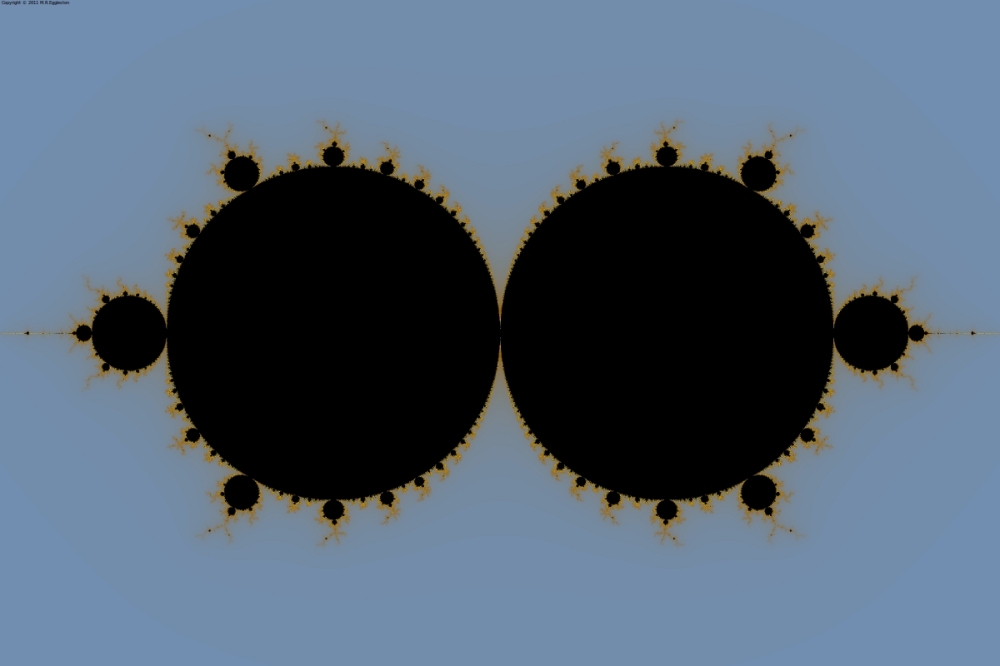Archive for December 2011
This is the fourth and final part of the guide to the Compasses fractal. The images produced with imaginary powers are much more complicated than the images we’ve seen so far for the Compasses fractal. The bailout condition (norm(z) > limit) is important as it has a great influence over the appearance of the fractal image.
The first image shows a distorted Mandelbrot in a tangled web of ribbons.

alpha = 1.75i, limit = 16000
The first image is coloured using iteration for outer colouring and black for inner colouring. To demonstrate the effect of changing the limit value we now zoom out and for the next 3 pictures we’ll use alpha = 2i, beta = 0 and vary the value of limit, the colouring methods stay the same.

limit = 16

limit = 1600

limit = 16000
Now for a change of scenery and a change in outer colouring, the following two pictures are the same except for the outer colouring method, there are no inner areas to colour. The image is a zoom in on an area above the horizontal line in the first segment containing a distorted Mandelbrot in the previous picture.

colour method = final magnitude (norm(z))

colour method = variance of angle
Finally an image with outer and inner colouring.

alpha = 1.75i, outer = variance of angle, inner = absolute log of minimum magnitude
I’ve only used two values for alpha 1.75i and 2i, these are good starting points for exploring the Compasses fractal with imaginary powers. I’m not going to cover complex powers, you can try them out yourselves, you will get similar results to the imaginary powers.
The Compasses fractal can be manipulated by applying various complex plane and formula transforms so there is a lot more to explore, that exploration will have to wait until I revisit this fractal in an other set of posts possibly to be called “Transformed Compasses” …
There are more fractal guides to come in the new year.
In part 3 of the guide to Compasses fractals we come negative values for alpha which produce fractal patterns within a disc (for negative integers for alpha). The examples will be for alpha values of -2 and -3, the colouring with be iteration for outer and black for inner. The fractal is sensitive to the limit used in the bailout condition: norm(z) > limit.

alpha = -2 limit = 16

alpha = -2 limit = 64
Unsurprisingly there are lots of Mandelbrot Islands present in the fractals.

zoom in of the previous picture

alpha = -3 limit = 6000
Finally the addition of the complex plane transform Power, -1.

inverted version of the previous picture
This is part 2 of the guide to Compasses fractals. This time I’m inverting them i.e. transforming the complex plane by applying a power of -1. This is the same transform that produces the Inverse Mandelbrot which I think resembles a trilobite. The last example is similar to the Inverse Mandelbrot but it appears to have swallowed what looks like a very fat Mandelbrot.
The formula for Compasses can be found in the part 1. All the examples use alpha = 2 and z0 = transformed c (c = c-1) and varying values of beta.

beta = 0

beta = -1

beta = -1.665

beta = -2

beta = 0.125
That’s it for Inverse Compasses, the next part will use negative values for alpha.
I’m currently writing a Saturn User Guide to be included in the Saturn package when Saturn is released and along with the user manual is the only thing that is holding back the release of Saturn and Titan.
The Saturn User Guide aims to give user’s of Saturn a starting point for various fractal types, eventually the guide will feature all the fractal types implemented in Saturn, the initial version will point the way where guidance is needed as it can be very frustrating being presented with a fractal type and a very uninteresting initial image (in some cases it may be a single colour rectangle), it will also include a guide to some other fractals for which guidance isn’t so pressing.
As hints and tips for Saturn can also apply to other fractal programs, I will publish here portions of the Saturn User Guide starting with the Compasses fractal. The fractal type is implemented in Saturn as:
z <- transform(z)
z <- zalpha – alpha*c(alpha – 1)*z + beta
Of course the transform line only applies to Saturn, in this post there are no transforms applied to the Compasses formula.
It can be seen from the formula that the initial value of z (z0) can not be zero if beta is also zero. Using alpha = 2, beta = 0 and z0 = 1 we get the following image which isn’t that interesting.

I’m not going to explore the Compasses fractal with z0 = 0 and varying values of beta because changing the value of z0 to the location in the complex plane is much more interesting. With z0 = c we get this:

Changing beta leads to some interesting effects:

beta = 0.0875

beta = -1

beta = -1.665 (Rotated 90 degrees)
So, that’s it for part 1, in part 2 I’ll show examples of Inverse Compasses, i.e. apply the power transform to the complex plane using a power of -1. In part 3: Compasses with a negative value for alpha and finally in part 4: imaginary values for alpha.






















